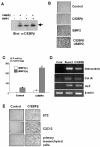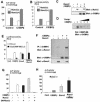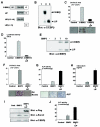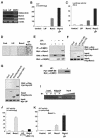A CCAAT/enhancer binding protein beta isoform, liver-enriched inhibitory protein, regulates commitment of osteoblasts and adipocytes
- PMID: 15713650
- PMCID: PMC549359
- DOI: 10.1128/MCB.25.5.1971-1979.2005
A CCAAT/enhancer binding protein beta isoform, liver-enriched inhibitory protein, regulates commitment of osteoblasts and adipocytes
Abstract
Although both osteoblasts and adipocytes have a common origin, i.e., mesenchymal cells, the molecular mechanisms that define the direction of two different lineages are presently unknown. In this study, we investigated the role of a transcription factor, CCAAT/enhancer binding protein beta (C/EBPbeta), and its isoform in the regulation of balance between osteoblast and adipocyte differentiation. We found that C/EBPbeta, which is induced along with osteoblast differentiation, promotes the differentiation of mesenchymal cells into an osteoblast lineage in cooperation with Runx2, an essential transcription factor for osteogenesis. Surprisingly, an isoform of C/EBPbeta, liver-enriched inhibitory protein (LIP), which lacks the transcriptional activation domain, stimulates transcriptional activity and the osteogenic action of Runx2, although LIP inhibits adipogenesis in a dominant-negative fashion. Furthermore, LIP physically associates with Runx2 and binds to the C/EBP binding element present in the osteocalcin gene promoter. These data indicate that LIP functions as a coactivator for Runx2 and preferentially promotes the osteoblast differentiation of mesenchymal cells. Thus, identification of a novel role of the C/EBPbeta isoform provides insight into the molecular basis of the regulation of osteoblast and adipocyte commitment.
Figures





Similar articles
-
CCAAT/enhancer-binding protein delta activates the Runx2-mediated transcription of mouse osteocalcin II promoter.J Mol Endocrinol. 2006 Jun;36(3):531-46. doi: 10.1677/jme.1.01944. J Mol Endocrinol. 2006. PMID: 16720721
-
CCAAT/enhancer-binding protein homologous protein (CHOP) regulates osteoblast differentiation.Mol Cell Biol. 2006 Aug;26(16):6105-16. doi: 10.1128/MCB.02429-05. Mol Cell Biol. 2006. PMID: 16880521 Free PMC article.
-
CCAAT/Enhancer binding protein beta abrogates retinoic acid-induced osteoblast differentiation via repression of Runx2 transcription.Mol Endocrinol. 2007 Sep;21(9):2124-35. doi: 10.1210/me.2006-0452. Epub 2007 Jun 19. Mol Endocrinol. 2007. PMID: 17579210
-
Requisite roles of Runx2 and Cbfb in skeletal development.J Bone Miner Metab. 2003;21(4):193-7. doi: 10.1007/s00774-002-0408-0. J Bone Miner Metab. 2003. PMID: 12811622 Review.
-
[Relationship between bone metabolism and adipogenesis].Clin Calcium. 2007 Feb;17(2):233-40. Clin Calcium. 2007. PMID: 17272881 Review. Japanese.
Cited by
-
CCAAT/enhancer binding protein beta regulates stem cell activity and specifies luminal cell fate in the mammary gland.Stem Cells. 2010 Mar 31;28(3):535-44. doi: 10.1002/stem.297. Stem Cells. 2010. PMID: 20054865 Free PMC article.
-
Runx2 represses myocardin-mediated differentiation and facilitates osteogenic conversion of vascular smooth muscle cells.Mol Cell Biol. 2008 Feb;28(3):1147-60. doi: 10.1128/MCB.01771-07. Epub 2007 Nov 26. Mol Cell Biol. 2008. PMID: 18039851 Free PMC article.
-
Regulation of Cartilage Development and Diseases by Transcription Factors.J Bone Metab. 2017 Aug;24(3):147-153. doi: 10.11005/jbm.2017.24.3.147. Epub 2017 Aug 31. J Bone Metab. 2017. PMID: 28955690 Free PMC article. Review.
-
C/EBPβ (CEBPB) protein binding to the C/EBP|CRE DNA 8-mer TTGC|GTCA is inhibited by 5hmC and enhanced by 5mC, 5fC, and 5caC in the CG dinucleotide.Biochim Biophys Acta. 2015 Jun;1849(6):583-9. doi: 10.1016/j.bbagrm.2015.03.002. Epub 2015 Mar 13. Biochim Biophys Acta. 2015. PMID: 25779641 Free PMC article.
-
Retinoic acid regulates commitment of undifferentiated mesenchymal stem cells into osteoblasts and adipocytes.J Bone Miner Metab. 2013 Jan;31(1):53-63. doi: 10.1007/s00774-012-0385-x. Epub 2012 Sep 27. J Bone Miner Metab. 2013. PMID: 23014973
References
-
- Ahrens, M., T. Ankenbauer, D. Schroder, A. Hollnagel, H. Mayer, and G. Gross. 1993. Expression of human bone morphogenetic proteins-2 or -4 in murine mesenchymal progenitor C3H10T1/2 cells induces differentiation into distinct mesenchymal cell lineages. DNA Cell Biol. 12:871-880. - PubMed
-
- Akune, T., S. Ohba, S. Kamekura, M. Yamaguchi, U. I. Chung, N. Kubota, Y. Terauchi, Y. Harada, Y. Azuma, K. Nakamura, T. Kadowaki, and H. Kawaguchi. 2004. PPARgamma insufficiency enhances osteogenesis through osteoblast formation from bone marrow progenitors. J. Clin. Investig. 113:846-855. - PMC - PubMed
-
- Bachner, D., M. Ahrens, D. Schroder, A. Hoffmann, J. Lauber, N. Betat, P. Steinert, L. Flohe, and G. Gross. 1998. Bmp-2 downstream targets in mesenchymal development identified by subtractive cloning from recombinant mesenchymal progenitors (C3H10T1/2). Dev. Dyn. 213:398-411. - PubMed
-
- Blake, T., N. Adya, C. H. Kim, A. C. Oates, L. Zon, A. Chitnis, B. M. Weinstein, and P. P. Liu. 2000. Zebrafish homolog of the leukemia gene CBFB: its expression during embryogenesis and its relationship to scl and gata-1 in hematopoiesis. Blood 96:4178-4184. - PubMed
Publication types
MeSH terms
Substances
LinkOut - more resources
Full Text Sources
Other Literature Sources
Molecular Biology Databases
Research Materials
